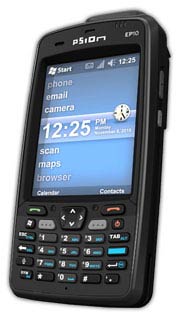|
Psion Teklogix Omnii EP10
A sensible, competent, multi-talented rugged PDA
(by Conrad H. Blickenstorfer)
In 2010, Psion introduced their "Modulus" concept (see here) geared to offer their customers the exact right handheld computer for a given job. Psion's goal was to modularize their hardware platforms as much as possible. Initially, the approach was limited to add-on and snap-on modules for their WORKABOUT, Ikôn and NEO handhelds, offering more configurability, exchangeable components, as well as guarding against obsolescence and opening the platforms to development by using open standards. The first full product based on the Modulus approach was the Omnii XT10 introduced in September of 2010. The approach, which is now called the Open Source Mobility concept, then yielded a next product line when, in December 2010, Psion followed with the announcement of the Omni EP10, to be available around April 2011.
 It's April 2011 as of this writing, and Psion announced that Warok GmbH in Germany placed an order for 1,000 units of the EP10, "following unprecedented customer interest," and that the EP10 would begin shipping within the first half of 2011 with larger volumes planned for the second half of 2011. So what is the Psion EP10? It's April 2011 as of this writing, and Psion announced that Warok GmbH in Germany placed an order for 1,000 units of the EP10, "following unprecedented customer interest," and that the EP10 would begin shipping within the first half of 2011 with larger volumes planned for the second half of 2011. So what is the Psion EP10?
In their December 2010 press release, Psion described it as a rugged PDA device that offers "all the functionality of high-end, full-size devices in a smaller form factor and at an affordable price" and that it would extend Psion's reach to a new category of buyers, "business users who employ consumer-grade smartphones and devices for commercial and industrial activities to deploy business applications into the field." This, of course, is a concept that has seen product introductions from most of the major handheld manufacturers over the past year. It's also a tough challenge because consumer expectations—spoiled by the elegance and ease of use of iPhones and Android devices and their apps—have risen greatly. Finally, modular concepts usually rely on common platforms for maximum efficiency and interchangeability of parts and components, but the EP10 has a PDA-style body whereas the XT10 uses the larger flashlight-style.
On its own merit, the EP10 appears a practical, sensible device. Measuring 3.1 x 6.2 x 1.2 inches and weighing 12.8 ounces, the EP10 is pretty substantial for a PDA-style handheld, but it is still pocketable. Its size enables a generously-sized 3.7-inch display with full VGA resolution, and there's also room for an expanded numeric keypad large enough to use even with gloves on.
For under the hood, Psion chose to forego the Marvell PXA processor platform that powers most of its handhelds except the recent XT10, and went with an 800MHz TI OMAP AM3715 Sitara ARM Cortex 8 processor with a PowerVR graphics accelerator. That's a mouthful, but also a good choice. It's the same chip that powers the high-end Trimble Ranger 3 that we recently reviewed and found to be an excellent performer. For software, Psion chose Windows Embedded Handheld 6.5.3, which, on the plus side, extends all the benefits of the Windows CE platform (leverage, software tools, experience, compatibility) but on the minus side seems an unhappy stop-gap effort by Microsoft (without going into much detail, Microsoft made an odd effort to add iPhone and Zune-style touch functionality that just doesn't work well with a resistive digitizer).
The rest of the tech specs are pretty standard and up-to-date. Users get 256MB of RAM, 2GB Flash, and a microSD slot for extra storage. Psion considers the battery "full-shift," there's a 3.2-megapixel AF camera with fual LED flash/illuminators, and a remarkable array of integrated sensors (accelerometer, digital compass, gyroscope, light sensor, proximity) that developers can use for innovative custom apps. Wireless includes 802.11a/b/g/n and Bluetooth v2.1, both a gen ahead of what the XT10 includes, and there is also SiRFstarIV-based GPS and a 2D imager. Combine that with the handy keypad, and the EP10 looks like a formidable data collection device. Then add the UMTS 3.8G HSPA + or CDMA EVDO Rev A radio options and full phone functionality and Psion's claim of the EP10 being a device for "commercial and industrial activities" becomes much clearer.
As far as ruggedness goes, the Psion EP10 covers all the bases with specs that are reasonable for this type of device. It can handle operating temperatures between 14 and 122 degrees Fahrenheit, wide enough for most applications. It can handle repeated 5-foot drops onto concrete, sensible for a device that may slip out of your hand when you're using it as a phone. Sealing is at the IP54 level, which means it's protected against dust and also against water sprayed from all directions, without but with "limited ingress permitted," i.e. let's not go overboard. Psion also cites a tumble spec: 250 tumbles from half a meter (1.7 feet). That means if you run around with it and drop it, no big deal. Psion further lists electrostatic discharge protection level and numerous regulatory approvals.
What's a bit less clear from early specs is wired I/O. Psion mentions sleves with apparently either USB and power or serial and power.
In terms of competition in the ruggedized smartphone/mobile computer/all-in-one field, the EP10 is larger and heavier than recent entries from Motorola, Intermec, etc., in this class. Devices closest to it may be the Datalogic Elf or the Handheld Nautz X5. Unlike commercial smartphones where most simply copy the iPhone, more ruggedized versions come in many sizes and nuances, and the intended application determines the perfect fit.
Based on what we've seen so far, with the EP10 Psion appears to have a no-nonsense, very rational device with strong features and technology.
|



